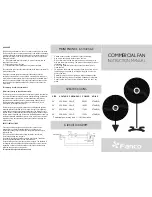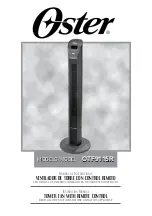
Radial-Rohrventilatoren Serie RRK ...
Ventilateurs Centrifuges série RRK ...
Centrifugal ’In-Line’ Duct Fans serie RRK ...
hinter dem Ventilator eine ausreichend lange gerade
Rohrstrebke vorgesehen wird, da sonst mit erhe-
blichen Leistungsminderungen und mit Geräuscher-
höhungen zu rechnen ist.
Achtung:
Die volle Ventilatorleistung wird nur erre-
icht, wenn freie An- und Abströmung gegeben ist.
Für ausreichende Motorkühlung muss sichergestellt
sein, dass eine Mindest-Luftströmungsfläche von 20
% des Ventilatorquerschnittes gegeben ist.
KONDENSWASSERBILDUNG
Bei periodischem Betrieb, bei feuchten und warmen
Fördermitteln und durch Temperaturschwankungen
(Aussetzbetrieb) entsteht innerhalb des Motors Kon-
densat, dessen Abfluß sichergestellt werden muss.
Falls sich in Rohrleitung u. Ventilatorgehäuse Kon-
densatz bilden kann, sind entsprechende Vorkehrun-
gen (Wassersack, Drainageleitung) bei der Installation
zu treffen. Der Motor darf keinesfalls mit Wasser
beaufschlagt werden.
FUNKTIONSSICHERHEIT - NOTBETRIEB
Bei Einsatz des Ventilators in wichtiger versorgung-
stechnischer Funktion, ist die Anlage so zu konzip-
ieren, dass bei Ventilator-Ausfall automatisch ein Not-
betrieb garantiert ist. Geeignete Lösungen sind z.B.:
Parallelbetrieb
von
zwei
leistungschwächeren
Geräten mit getrenntem Stromkreis, stand-by Venti-
lator, Alarmeinrichtungen und Notlüftungssysteme.
ELEKTRISCHER ANSCHLUSS
Vor allen Wartungs- und Installationsarbeiten
ist das Gerät allpolig vom Netz zur trennen.
Der elektrische Anschluss darf nur von einer au-
torisierten Elektrofachkraft ausgeführt werden. Die
einschlägigen
Sicherheits-
und
Installations-
vorschriften sind zu beachten. Zwingend vorge-
schrieben ist ein allpoliger Netztrennschalter mit min-
destens 3 mm Kontaktöffnung. Netzspannung und
Frequenz müssen mit den Angaben des Motorleis-
tungsschildes übereinstimmen.
Bei Anschluss an Kunststoff-Klemmenkästen dürfen
keine Kabelverschraubungen aus Metall verwendet
werden. Die Einführung der Zuleitung so vornehmen,
dass bei Wasserbeaufschlagung kein Eindringen ent-
lang der Leitung ermöglicht wird.
Leitung nie über scharfe Kanten führen. Anschluss
entsprechend aufgedrucktem Schema an Klemm-
kastendeckelunterseite vornehmen. Schutzleiter an
Erdungsklemme anschließen.
Für Servicearbeiten einen allpolig abschaltenden
Reparaturschalter in unmittelbarer Nähe des Ventila-
tors vorsehen.
Weitere Arbeitsgänge siehe unter Abschnitt "Inbe-
triebnahme".
MOTORSCHUTZ
Alle Typen sind, mit der Wicklung in Reihe ver-
drahteten Thermokontakten, ausgerüstet. Schutz
durch selbsttätiges Auslösen - nach erfolgter Abküh-
lung selbsttätiges Wiedereinschalten.
Achtung:
- Bei häufigen Auslösen des Thermokontakts (Still-
stand) muss Ventilator überprüft werden.
- Vor Arbeiten am Ventilator diesen allpolig vom Netz
trennen
(siehe
"Elektrischer
Anschluss")
da
Thermokontakt evtl. selbsttätig einschaltet.
INBETRIEBNAHME
Folgende Kontrollarbeiten sind auszuführen:
- Bestimmungsgemäßen Einsatz des Ventilators
überprüfen.
- Netzspannung mit Leistungsschildangabe verglei-
chen.
- Ventilator auf solide Befestigung prüfen.
- Alle Teile, insbesondere Schrauben, Muttern,
Schutzgitter auf festen Sitz überprüfen.
MONTAGE
Les ventilateurs standard sont livrés complets as-
semblés, prêts à raccorder. Ils peuvent être installés
en position verticale, horizontale ou inclinée.
INSTALLATION
Lors de l'installation, il faut veiller à limiter la transmis-
sion de bruits par vibration. Il est donc conseille de
prévoir des colliers de fixation BM (accessoire, fig. 1)
pour le raccordement en gaine. Par ailleurs, la conso-
le de montage MK 4 (accessoire) est toujours un
moyen simple et pratique defixer le ventilateur au mur
ou au plafond. Dans ce type de montage, il est né-
cessaire de prévoir un joint isolant élastique entre
mur et pied-support pour éviter les transmissions
éventuelles de bruit par vibration. Pour une installati-
on en gaine, il est également nécessaire de laisser en
amont et en aval de l'appareil une longueur de,gaine
droite suffisante. Cette disposition évite des chutes
de rendement et l'augmentation de l'intensité sonore.
Attention:
Le débit maximum d'un ventilateur n'est
effectif que si l'entrée ou la sortie d'air a été normale-
ment dimensionnée dans l'installation. Pour un refro-
idissement suffisant du moteur, il est nécessaire d'as-
surer des surfaces de passage d'air au moins égales
à 20 % de la section du ventilateur.
FORMATION DE CONDENSES
En cas de fonctionnement intermittent, de transport
de fluides humides ou chauds, de variations de tem-
pérature, il se forme à l'intérieur du moteur un con-
densat (condensation d'eau) qui doit absolument être
évacué.
S'il y a des risques de condensation dans la gaine, et
l'enveloppe du ventilateur, il est nécessaire de prévoir
une boucle de condensate avec évacuation. L'eau ne
doit en aucun cas pénétrer dans le moteur.
Le non-respect de la règle d'évacuation des conden-
sats entraîne la perte de garantie.
SÉCURITÉ DE FONCTIONNEMENT - SYSTÈ-
ME DE SECOURS
Lorsque le ventilateur a une fonction technique déter-
minante, l'installation doit être conçue de sorte qu'un
système de secours soit automatiquement assuré en
cas de défaillance du ventilateur. Les solutions suiv-
antes peuvent être envisagées: fonctionnement si-
multané de deux appareils de performances in-
férieures sur deux enceintes séparées ventilateur en
stand-by, dispositifs d'alarme, systèmes d'aération
de secours.
BRANCHEMENT ÉLECTRIQUE
Le branchement électrique doit être effectué par un
électricien qualifié et autorisé.
Attention:
Tous les travaux doivent être effectués
hors tension.
Les consignes de sécurité et les règles d'installation
en vigueur doivent être respectées. La prescription
suivante doit absolument être appliquée:
disjoncteur omnipolaire avec ouverture de contact
d'au moins 3 mm. La tension secteur et la fréquence
doivent correspondre aux indications de la plaque
signalétique du moteur.
Pour des branchements sur des boites à bornes en
matière synthétique, il est interdit d'utiliser des press-
es-étoupes métalliques.
Le passage du câble d'alimentation doit être effectué
de telle sorte qu'un éventuel filet d'eau ne puisse pas
s'infiltrer le long du câble.
Ne jamais faire passer le câble par-dessus d'objets
coupants.
Raccordement suivant schéma imprimé, à l'intérieur
du couvercle de boite à bornes. Raccorder l'appareil
à la terre par le câble et la borne correspondante.
Pour des travaux de maintenance, un interrupteur
coupant tous les pôles doit être installé à proximité
INSTALLATION
When installing pay attention to obviate body sound
transmission, e.g. by using fastening clamps BM (ac-
cessorie, pict. 1). The mounting bracket MK 4 (ac-
cessorie) is an easy means of fixing the ventilator on
wall or ceiling. To avoid transmission of noise, insert
elastic layer between wall and MK. When installing in
ducts make sure that there is a sufficiently long,
straight piece of duct in front and behind the fan as
otherwise considerable performance reduction and
noise increase will result.
Attention: The max. fan performance can only be
achieved if unhindered suction and discharge is pro-
vided. For a sufficient cooling of the motor a minimum
air-flow area of 20 % of the fan cross section must be
guaranteed.
CONDENSER-WATER DEVELOPMENT
In case of periodical use, moist and warm media and
through temperature variations (intermittent service),
condensate is built up in the motor and its draining off
must be ensured.
In case of condensation in ducting and casing of the
ventilator appropriate meassures must be taken (wa-
ter bag, drainage) during installation. Under no cir-
cumstances must the motor be covered by moist-
ness.
In case of damage through incorrect installation HE-
LIOS is released from all guarantee claims.
SAFETY OF OPERATION - EMERGENCY OPE-
RATION
When using the fan in important functions it must be
installed so that in case of a fan breakdown an emer-
gency operation is guaranteed. Suitable solutions
are: parallel operation of 2 devices of lower perfor-
mance with separated current supply, standby fan,
alarm and emergency ventilation systems.
ELECTRICAL CONNECTION
Electrical connection may only be carried out by spe-
cially trained and approved personnel.
Attention:
All work only in dead state. All relevant
safety and installation regulations are to be observed.
- an all-pole mains switch with a minimum contact
opening of 3 mm and Power-supply voltage and
frequency must correspond to the data on the mo-
tor rating plate.
When connecting to plastic terminal boxes no metal
screw-type conduit fittings may be used. The intro-
duction of the power cable must be done such that in
case of water an entry along the power-supply cable
is impossible. The connecting cable may not touch
sharp objects. Connect according to diagram shown
on termal box.
Connect protective conductor to grounding terminal.
For further working processes see "Putting into oper-
ation".
For maintenance an all-pole disconnecting isolator
should be installed directly by the fan.
Abb. 1
























